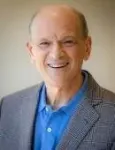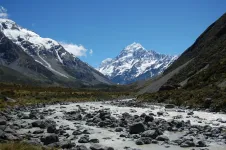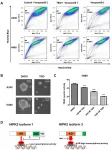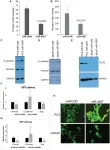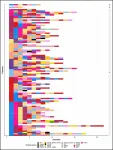(Press-News.org) DURHAM, N.C. -- Researchers at Duke University have revealed long-hidden molecular dynamics that provide desirable properties for solar energy and heat energy applications to an exciting class of materials called halide perovskites.
A key contributor to how these materials create and transport electricity literally hinges on the way their atomic lattice twists and turns in a hinge-like fashion. The results will help materials scientists in their quest to tailor the chemical recipes of these materials for a wide range of applications in an environmentally friendly way.
The results appear online March 15 in the journal Nature Materials.
"There is a broad interest in halide perovskites for energy applications like photovoltaics, thermoelectrics, optoelectronic radiation detection and emission -- the entire field is incredibly active," said Olivier Delaire, associate professor of mechanical engineering and materials science at Duke. "While we understand that the softness of these materials is important to their electronic properties, nobody really knew how the atomic motions we've uncovered underpin these features."
Perovskites are a class of materials that -- with the right combination of elements -- are grown into a crystalline structure that makes them particularly well-suited for energy applications. Their ability to absorb light and transfer its energy efficiently makes them a common target for researchers developing new types of solar cells, for example. They're also soft, sort of like how solid gold can be easily dented, which gives them the ability to tolerate defects and avoid cracking when made into a thin film.
One size, however, does not fit all, as there is a wide range of potential recipes that can form a perovskite. Many of the simplest and most studied recipes include a halogen--such as chlorine, fluorine or bromine -- giving them the name halide perovskites. In the crystalline structure of perovskites, these halides are the joints that tether adjoining octahedral crystal motifs together.
While researchers have known these pivot points are essential to creating a perovskite's properties, nobody has been able to look at the way they allow the structures around them to dynamically twist, turn and bend without breaking, like a Jell-O mold being vigorously shaken.
"These structural motions are notoriously difficult to pin down experimentally. The technique of choice is neutron scattering, which comes with immense instrument and data analysis effort, and very few groups have the command over the technique that Olivier and his colleagues do," said Volker Blum, professor of mechanical engineering and material science at Duke who does theoretical modeling of perovskites, but was not involved with this study. "This means that they are in a position to reveal the underpinnings of the materials properties in basic perovskites that are otherwise unreachable."
In the study, Delaire and colleagues from Argonne National Laboratory, Oak Ridge National Laboratory, the National Institute of Science and Technology, and Northwestern University, reveal important molecular dynamics of the structurally simple, commonly researched halide perovskite (CsPbBr3) for the first time.
The researchers started with a large, centimeter-scale, single crystal of the halide perovskite, which is notoriously difficult to grow to such sizes -- a major reason why this sort of dynamic study has not been achieved before now. They then barraged the crystal with neutrons at Oak Ridge National Laboratory and X-rays at Argonne National Laboratory. By measuring how the neutrons and X-rays bounced off the crystals over many angles and at different time intervals, the researchers teased out how its constituent atoms moved over time.
After confirming their interpretation of the measurements with computer simulations, the researchers discovered just how active the crystalline network actually is. Eight-sided octahedral motifs attached to one another through bromine atoms were caught twisting collectively in plate-like domains and constantly bending back and forth in a very fluid-like manner.
"Because of the way the atoms are arranged with octahedral motifs sharing bromine atoms as joints, they're free to have these rotations and bends," said Delaire. "But we discovered that these halide perovskites in particular are much more 'floppy' than some other recipes. Rather than immediately springing back into shape, they return very slowly, almost more like Jell-O or a liquid than a conventional solid crystal."
Delaire explained that this free-spirited molecular dancing is important to understand many of the desirable properties of halide perovskites. Their 'floppiness' stops electrons from recombining into the holes the incoming photons knocked them out of, which helps them make a lot of electricity from sunlight. And it likely also makes it difficult for heat energy to travel across the crystalline structure, which allows them to create electricity from heat by having one side of the material be much hotter than the other.
Because the perovskite used in the study -- CsPbBr3 -- has one of the simplest recipes, yet already contains the structural features common to the broad family of these compounds, Delaire believes that these findings likely apply to a large range of halide perovskites. For example, he cites hybrid organic-inorganic perovskites (HOIPs), which have much more complicated recipes, as well as lead-free double-perovskite variants that are more environmentally friendly.
"This study shows why this perovskite framework is special even in the simplest of cases," said Delaire. "These findings very likely extend to much more complicated recipes, which many scientists throughout the world are currently researching. As they screen enormous computational databases, the dynamics we've uncovered could help decide which perovskites to pursue."
INFORMATION:
This research was supported by the Department of Energy (DE-SC0019299, DE-SC0019978, DE-AC02-05CH11231).
CITATION: "Two-Dimensional Overdamped Fluctuations of Soft Perovskite Lattice in CsPbBr3" T. Lanigan-Atkinsy, X. Hey, M. J. Krogstad, D. M. Pajerowski, D. L. Abernathy, Guangyong NMN Xu, Zhijun Xu,4 D.-Y. Chung, M. G. Kanatzidis, S. Rosenkranz, R. Osborn and O. Delaire. Nature Materials, March 15, 2021. DOI: 10.1038/s41563-021-00947-y
An epigenetic modification that occurs in a major cell type in the brain's reward circuitry controls how stress early in life increases susceptibility to additional stress in adulthood, researchers at the Icahn School of Medicine at Mount Sinai have learned. In a study in Nature Neuroscience, the team also reported that a small-molecule inhibitor of the enzyme responsible for this modification, currently being developed as an anti-cancer drug, was able to reverse increased vulnerability to lifelong stress in animal models.
"It has long been known that stress exposures throughout life control lifelong susceptibility to subsequent stress. Here ...
Researchers have found that out of the more than 300 COVID-19 machine learning models described in scientific papers in 2020, none of them is suitable for detecting or diagnosing COVID-19 from standard medical imaging, due to biases, methodological flaws, lack of reproducibility, and 'Frankenstein datasets.'
The team of researchers, led by the University of Cambridge, carried out a systematic review of scientific manuscripts - published between 1 January and 3 October 2020 - describing machine learning models that claimed to be able to diagnose or prognosticate ...
In considering materials that could become the fabrics of the future, scientists have largely dismissed one widely available option: polyethylene.
The stuff of plastic wrap and grocery bags, polyethylene is thin and lightweight, and could keep you cooler than most textiles because it lets heat through rather than trapping it in. But polyethylene would also lock in water and sweat, as it's unable to draw away and evaporate moisture. This antiwicking property has been a major deterrent to polyethylene's adoption as a wearable textile.
Now, MIT engineers have spun polyethylene into fibers ...
The loss of glaciers worldwide enhances the breakdown of complex carbon molecules in rivers, potentially contributing further to climate change.
An international research team led by the University of Leeds has for the first time linked glacier-fed mountain rivers with higher rates of plant material decomposition, a major process in the global carbon cycle.
As mountain glaciers melt, water is channelled into rivers downstream. But with global warming accelerating the loss of glaciers, rivers have warmer water temperatures and are less prone to variable water flow and sediment movement. These conditions are then much more favourable for fungi to establish and ...
Ageing is a common factor in many diseases. So, what if it were possible to treat them by acting on the causes of ageing or, more specifically, by acting on the shortening of telomeres, the structures that protect chromosomes? This strategy is being pursued by the Telomeres and Telomerase Group of the Spanish National Cancer Research Centre (CNIO), which has already succeeded to cure pulmonary fibrosis and infarctions in mice by lengthening telomeres. Now they take a first step towards doing the same with renal fibrosis by demonstrating that short telomeres are at the origin of this disease, ...
Oncotarget published "Folinic acid in colorectal cancer: esquire or fellow knight? Real-world results from a mono institutional, retrospective study" which reported that the stock of therapeutic weapons available in metastatic colorectal cancer has been progressively grown over the years, with improving both survival and patients' clinical outcome: notwithstanding advances in the knowledge of mCRC biology, as well as advances in treatment, fluoropyrimidine antimetabolite drugs have been for 30 years the mainstay of chemotherapy protocols for this malignancy.
5-Fluorouracil seems to act differently depending on administration method: elastomer-mediated continuous infusion better inhibits Thymidylate ...
Oncotarget published "A novel isoform of Homeodomain-interacting protein kinase-2 promotes YAP/TEAD transcriptional activity in NSCLC cells" which reported that In this study, the authors show that a new HIPK2 isoform increases TEAD reporter activity in NSCLC cells.
They detected and cloned a novel HIPK2 isoform 3 and found that its forced overexpression promotes TEAD reporter activity in NSCLC cells.
Expressing HIPK2 isoform 3_K228A kinase-dead plasmid failed to increase TEAD reporter activity in NSCLC cells.
Next, they showed that two siRNAs targeting HIPK2 decreased HIPK2 isoform 3 and YAP protein levels in NSCLC cells.
In summary, this Oncotarget study indicates that HIPK2 isoform 3, the main HIPK2 isoform ...
The cover for issue 51 of Oncotarget features Figure 5, "miR-4287 overexpression regulates EMT in prostate cancer cell lines," published in "MicroRNA-4287 is a novel tumor suppressor microRNA controlling epithelial-to mesenchymal transition in prostate cancer" by Bhagirath, et al. which reported that the authors analyzed the role of miR-4287 in PCa using clinical tissues and cell lines.
Receiver operating curve analysis showed that miR-4287 distinguishes prostate cancer from normal with a specificity of 88.24% and with an Area under the curve of 0.66. Further, these authors found that miR-4287 ...
NEW YORK, NY (March 15, 2021)--A cytokine "hurricane" centered in the lungs drives respiratory symptoms in patients with severe COVID-19, a new study by immunologists at Columbia University Vagelos College of Physicians and Surgeons suggests.
Two cytokines, CCL2 and CCL3, appear critical in luring immune cells, called monocytes, from the bloodstream into the lungs, where the cells launch an overaggressive attempt to clear the virus.
Targeting these specific cytokines with inhibitors may calm the immune reaction and prevent lung tissue damage. Currently, one drug that blocks immune responses to CCL2 is being studied in clinical trials of patients with severe COVID-19.
Survivors of severe COVID-19, the study also found, had a greater abundance of antiviral T cells in their lungs ...
Philadelphia, March 15, 2021 - Biomarker testing surveys specific disease-associated molecules to predict treatment response and disease progression; however its use has complicated the diagnosis of non-small-cell lung cancer (NSCLC). In a new study in The Journal of Molecular Diagnosis, published by Elsevier, investigators provide for the first time a complete overview of biomarker testing, spanning multiple treatment lines, in a single cohort of patients.
Using exploratory data analysis and process-mining techniques in a real-world setting, investigators identified significant variation in test utilization and treatment. They also found that while ...

